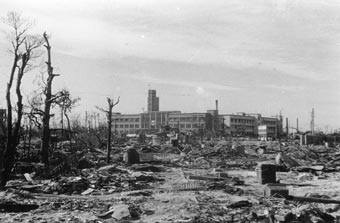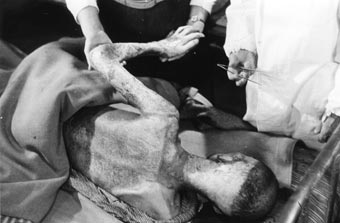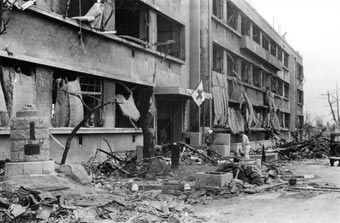Entering a City in Ruins
Filming by the Medical Team
Filming started on October 1, a date that coincided with the cutting off of medical services under the Wartime Casualties Care Law, which resulted in the eventual closing of all first-aid stations. However, medical assistance continued in hospitals and remaining first-aid stations, and many victims were still suffering from injuries caused by the A-bomb. Although deeply affected by the conditions of those suffering from horrendous injuries, the staff overcame their resistance and captured many on film. The medical team film differed from the others, focusing primarily on injured victims.

[39]
Hiroshima Red Cross Hospital standing in charred rubble
October 1945 Senda-machi 1-chome
1,500m from the hypocenter Photo by Shunkichi Kikuchi
At the Hiroshima Red Cross Hospital, only the structure's exterior remained; its windows had been blown off and its interior was destroyed. From the day of the bombing, the hospital was inundated with injured people. |

[40]
Man exposed to A-bomb heat rays from behind
October 5 to 6, 1945 Senda-machi 1-chome Hiroshima Red Cross Hospital
1,500m from the hypocenter Photo by Shunkichi Kikuchi
Tadataka Sasaki, shown in the film, was exposed to the bomb near Hiroshima Castle. When he came to, he had been blown all the way to the castle's outer moat. Despite his severe burns, he managed to escape to the riverbed for safety. The next day, he was carried by a truck to Fukuya Department Store, which had become a relief station. Later, he was admitted to the Hiroshima Red Cross Hospital. Application of Rivanol with gauze was the only treatment he received. Sasaki says that the changing of the gauze over his burn was extremely painful. |

[41]
Fukuromachi Elementary School
October 5 to 7, 1945 Fukuro-machi
460m from the hypocenter Photo by Shunkichi Kikuchi |

[42]
Treatment room in school building
October 5 to 7, 1945 Fukuro-machi Fukuromachi Elementary School
460m from the hypocenter Photo by Shunkichi Kikuchi
The heavily damaged school building did not have sufficient equipment, so a treatment room was set up in the space under the stairs. Even though injured herself and not in good health, the doctor (center) provided outpatient care with just a small staff. |

[43]
Rice water given to patients
October 20, 1945 Kusatsu-higashi-machi (now, Kusatsu-higashi 2-chome)
Kusatsu Elementary School 4,700m from the hypocenter Taken by Japan Film Corporation (Masao Yamanaka)
Victims were provided with hot meals and rice balls from neighboring areas. Local residents also provided nursing care as diligent rescue and relief activities continued. |

[44]
Symptoms thought to indicate infectious disease
October 22, 1945 Ebisu-cho Fukuya Department Store
710m from the hypocenter Taken by Japan Film Corporation
Because of such symptoms as high fever and diarrhea, doctors concluded that patients had dysentery; therefore, an infectious disease hospital was set up in Fukuya Department Store. Paper signs were attached to futons, stating, "Danger! Material used by patient with infectious disease. Do not touch!" |






